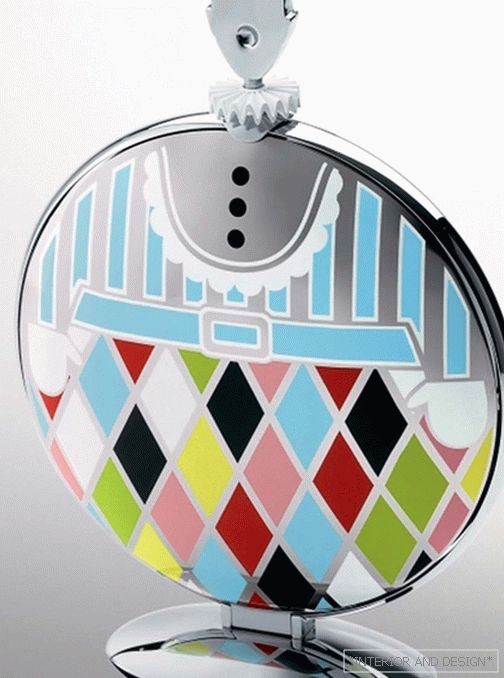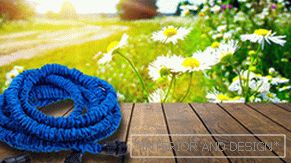 Summer is, as you know, the holiday season, and many associate it with hot days. However, in the conditions of the scorching sun, moisture begins to evaporate from the soil much faster, as a result, the earth becomes lifeless. It is on such days that the dacha residents have the most difficult time, because they have to water the plants additionally, providing them with the necessary moisture. If some plants can be watered by hand, then with shrubs and trees, everything is much more complicated.
Summer is, as you know, the holiday season, and many associate it with hot days. However, in the conditions of the scorching sun, moisture begins to evaporate from the soil much faster, as a result, the earth becomes lifeless. It is on such days that the dacha residents have the most difficult time, because they have to water the plants additionally, providing them with the necessary moisture. If some plants can be watered by hand, then with shrubs and trees, everything is much more complicated.
However, today there is an opportunity to simplify the irrigation process. To do this, you can use such a convenient tool as a garden hose. But for him to become a loyal assistant gardener, you need to choose the right hose for watering. And considering what a large number of options are presented today in shops for giving, it is not so easy to make the right decision.
It should be remembered that through the use of devices for watering gardener gets the opportunity to save themselves from performing labor-intensive operations. For this reason, you need to competently approach his choice. And the main requirement that it must satisfy is the high quality of performance. Therefore, it is not recommended to choose cheap analogues. In order not to be mistaken with the choice of garden hose, you need to adhere to certain criteria, given that you can choose a device for watering that can cope with its task most effectively.
Content
- 1 Which watering hose is better?
- 2 Watering hose sizes
- 2.1 Additional accessories
- 3 Criteria for choosing a hose for irrigation
- 3.1 Water pressure
- 4 Use and storage of garden hose
- 5 Conclusion
Which watering hose is better?
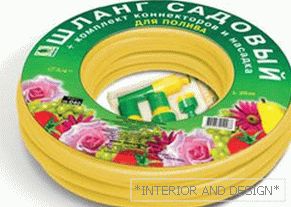 Most often, summer residents use rubber hoses, because besides the fact that they are not afraid of temperature fluctuations, they are, in addition to everything, immune to various types of deformation. Differing in quite considerable weight, such device for watering can contain up to 4 layers of insulation, thanks to which he can cope with pressure up to 40 atmospheres. If you correctly use a garden hose, then it can serve as a summer resident for watering for over 20 years.
Most often, summer residents use rubber hoses, because besides the fact that they are not afraid of temperature fluctuations, they are, in addition to everything, immune to various types of deformation. Differing in quite considerable weight, such device for watering can contain up to 4 layers of insulation, thanks to which he can cope with pressure up to 40 atmospheres. If you correctly use a garden hose, then it can serve as a summer resident for watering for over 20 years.
Also noteworthy are nylon products, the main advantages of which are high flexibility, durability and low weight. However, these products do not tolerate exposure to critical temperatures. Extremely negative impact on it has a pressure in excess of 5 atmospheres. Usually manufacturers give a guarantee for such hoses no more than 1 year.
PVC-based watering devices stand out for their flexibility and the presence of fabric pads in the structure. Because of this, they are able to tolerate any frost, but it is still undesirable to subject them to such tests, since this leads to a decrease in flexibility. Such hoses are able to successfully carry pressure up to 35 atmospheres.
A special kind of PVC hoses are products equipped with mesh reinforced coating. This addition allows for a good uniform water pressure. The structure of such products includes two internal layers, allowing them to withstand water pressure up to 35 atmospheres. Low temperatures have a negative effect on the performance of the irrigation device, resulting in a decrease in its flexibility.
Transparent plastic irrigation devices are not only lightweight, but also stand out high flexibility and brittleness. Any kink and exposure to low temperatures causes serious deformation, making it unsuitable for use. Transparency creates favorable conditions for the development of toxic algae in water, and this has a negative effect on plants. Over time, a lime scurf appears on the walls of such hoses, so instead of them it is better to choose a more reliable and safe product.
Flat devices for watering are interesting primarily low weight and flexibility. At the same time, they are highly brittle and able to stick together in the absence of water. You can use them only after they are promoted. Such a device for irrigation is able to cope with a pressure of not more than 5 atmospheres.
Spray products differ from the above options in that they have three micro holes for spraying water, which are located at the same distance from each other. Made of PVC, these hoses are not only flexible, but also perfectly withstand mechanical loads.
Watering hose sizes
 One of the main characteristics that you need to pay attention to when choosing - inner diameter. This parameter should be selected based on the speed with which the water should be supplied. The fact that the watering device has a large section provides a low pressure, and when the section is too small, the water pressure will be insufficient. Therefore, before you go to the store for a device for watering, you should determine the pressure and water flow.
One of the main characteristics that you need to pay attention to when choosing - inner diameter. This parameter should be selected based on the speed with which the water should be supplied. The fact that the watering device has a large section provides a low pressure, and when the section is too small, the water pressure will be insufficient. Therefore, before you go to the store for a device for watering, you should determine the pressure and water flow.
Most often on sale it is possible to meet products with a diameter of 1/2 inches (13 mm). This is the diameter of a standard faucet. In addition, consumers have the opportunity to purchase hoses 3/4 inch (19 mm), 1 inch (25 mm). Devices for irrigation standard size 1/2 inch are presented in stores in the form of bays from 20 to 100 meters. At the same time, it is possible to purchase products of non-standard sizes, which are offered in lengths from 1 meter.
Optional accessories
To use watering tools, accessories and accessories are needed to complement it. However, they must be selected according to the diameter of the hose.
Mandatory elements are:
- tee;
- nippel;
- water sprayer;
- corner of
In cases where the irrigation device has already been purchased with the nozzles, but they differ in diameter, then for use in the system of such a hose you can buy special adapters with which you can make the transition from one diameter to another.
Criteria for choosing a hose for irrigation
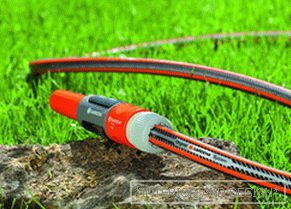 In order not to be mistaken with the choice of devices for watering, you need take into account a number of parameters. Considering the different types of these products, first of all, you need to take into account the material used for the manufacture of hoses, as well as the number of layers present in the structure. The most durable have devices for irrigation, made of rubber, which provide about 3-4 layers of coating with reinforced thread.
In order not to be mistaken with the choice of devices for watering, you need take into account a number of parameters. Considering the different types of these products, first of all, you need to take into account the material used for the manufacture of hoses, as well as the number of layers present in the structure. The most durable have devices for irrigation, made of rubber, which provide about 3-4 layers of coating with reinforced thread.
Despite the fact that they exceed the cost of many types of similar products and have significant weight, they are distinguished by such a significant advantage as a long service life. When choosing plastic hoses, keep in mind that the price of the product is an indicator of their quality. Such products are prone to bending, can quickly deform and lose their performance. Therefore, it is not recommended to purchase such hoses, otherwise at the most necessary moment you will have to urgently look for a replacement.
Water pressure
Selecting hoses, you need to remember about the pressure of water. To avoid rupture of the hose, you should choose a product that can withstand a pressure of 5 atmospheres. By purchasing a flexible hose, it will be easier for you to do watering in the country, because there will definitely be many hard-to-reach places that are difficult to reach without harming flower beds or garden beds. In order for the hose to be resistant to kinks, it is recommended to choose products that have an inner sheath.
Plastic products usually do not cope with exposure to critical temperatures of any range. The best option in this regard is a PVC-based hose. He is not afraid of temperatures in the range from - 20 to + 60 degrees. When choosing a hose you need to pay attention to the material that is used for its manufacture. He must have the following qualities:
- be environmentally friendly;
- thin out a sharp unpleasant smell.
During irrigation, it will not hurt you to have a coil: winding a hose on it will make it easier for you to use it and avoid bends and deformation. Usually such coils are made of high-quality plastic or metal, supplemented with anti-corrosion coating.
Coils are made in two versions:
- portable;
- stationary.
Most often their mounted on the wall. Before you install the coil, you should choose the right place for it - if you make a mistake, then the relocation will require enough time and effort on your part.
Use and storage of garden hose
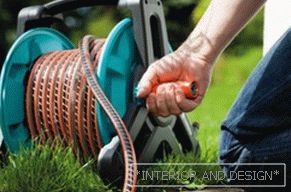 When using a hose for irrigation, keep in mind that the material used to make it is extremely affected by low temperatures. This is fraught with a deterioration in the elasticity of the hose and the appearance of cracks on its surface. For this reason, it is better to keep the hoses for the winter in a heated room in your home, cellar or warm garage. If possible, it is recommended to refrain from using the hose in cold weather. However, even if you decide to do this, after finishing watering, you immediately need to move it to a warm room and remove the remaining water from it. It is important to prevent water from freezing, otherwise it will cause cracks.
When using a hose for irrigation, keep in mind that the material used to make it is extremely affected by low temperatures. This is fraught with a deterioration in the elasticity of the hose and the appearance of cracks on its surface. For this reason, it is better to keep the hoses for the winter in a heated room in your home, cellar or warm garage. If possible, it is recommended to refrain from using the hose in cold weather. However, even if you decide to do this, after finishing watering, you immediately need to move it to a warm room and remove the remaining water from it. It is important to prevent water from freezing, otherwise it will cause cracks.
If you have to use short hosethen it is advisable to keep it in limbo. Thus, you will not allow water to accumulate inside it. After each use it must be immediately disconnected and put in the shade to protect from the negative effects of direct sunlight. If this is not done, thermal deformation may occur.
If you purchased a good quality hose with a multi-layer structure, then if you follow the rules for using it and the storage conditions, you can expect that it will serve you for at least 6 years. Single-layer hoses are extremely inconvenient and short-lived - usually they are enough for no more than 5 years. Even if you notice that the hose began to deteriorate, you should not immediately throw it away. It can prolong its life, for which the most damaged areas are cut off and the fragments formed are connected using adapters.
Conclusion
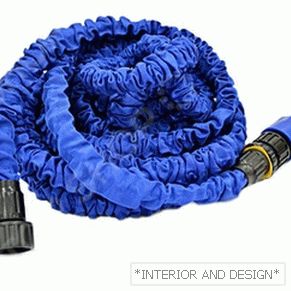 Garden hose for watering - an indispensable thing for any gardener. However, in order to most effectively cope with this function, you need choose the right hose. Here the focus should be on characteristics that will ensure efficient operation and long service life.
Garden hose for watering - an indispensable thing for any gardener. However, in order to most effectively cope with this function, you need choose the right hose. Here the focus should be on characteristics that will ensure efficient operation and long service life.
Therefore, the main parameter that must be considered when choosing, is the material from which the hose is made. Moreover, the latter must be reliable and durable, and also be able to withstand the effects of any temperature.

